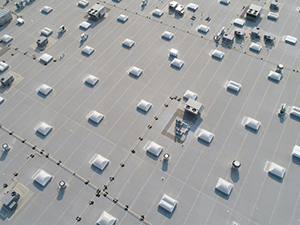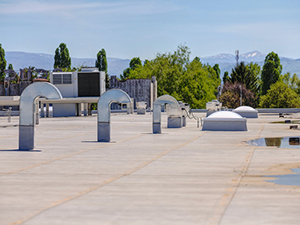
For commercial building owners in Ontario, CA, skylights are a functional design choice that bring natural light into workspaces, reduce energy costs, and enhance indoor environments. However, over time, skylights can deteriorate due to age, weather exposure, or structural issues, leading to leaks, drafts, or fading light performance. When signs of damage become clear, skylight replacement becomes not just a renovation option—but a necessity. To ensure a safe and efficient replacement process in Ontario, CA, contact Shark Commercial Roofing Systems at (213) 466-0074 for expert support.
Process of Skylight Replacement
Step 1: Assessing the Existing Skylight and Planning the Replacement
The first phase in any skylight replacement involves a detailed inspection and assessment. Commercial skylights may be subject to unique stressors, such as increased UV exposure, rooftop traffic, or equipment proximity, all of which can accelerate wear. Common signs that replacement is needed include:
- Water leaks or condensation build-up
- Discoloration, fogging, or cracking of the glass
- Increased indoor heat or glare
- Frame corrosion or poor fit due to shifting roofing material
Once a professional evaluates the current skylight, they’ll determine whether repair is viable or if full replacement is the more economical long-term solution. At this point, a site survey is also conducted to ensure the dimensions, mounting style (curb-mounted or deck-mounted), and material preferences are noted. Some commercial properties in Ontario opt for energy-efficient upgrades such as double-glazed glass or UV-blocking acrylic to meet Title 24 building efficiency standards.
Step 2: Preparing the Roof and Removing the Old Skylight
Once the replacement has been approved, the next step is preparation and removal. Proper timing is critical—especially in Southern California’s seasonal weather—to ensure the building is not left vulnerable to rain or strong winds during the replacement.

The old skylight is carefully removed, ensuring no damage is caused to the surrounding roof system. This often involves detaching flashing and sealants, which must be fully stripped to install the new unit properly. During this phase, it’s common for professionals to inspect the curb and surrounding decking to ensure there’s no water damage, mold, or rot. If these issues are found, they must be addressed before proceeding.
Commercial roofs often feature large or multiple skylights. In such cases, logistics like safety barriers, roof access, and downtime planning are essential to ensure business operations aren’t disrupted during replacement.
Step 3: Installing and Sealing the New Skylight
Once the area is prepped, the new skylight is positioned and secured into place, ensuring it aligns precisely with the existing opening. Correct installation and sealing are key to long-term performance, especially in Ontario’s mix of sunny and rainy seasons. Flashing kits—usually metal or composite—are installed around the unit to create a watertight barrier.
High-performance sealants and weatherproof tapes are then applied to eliminate any potential for air or water infiltration. Attention is also given to insulation and thermal breaks to help the skylight maintain interior climate control and reduce HVAC strain.
After installation, contractors typically perform a water test to confirm leak-proof integrity and inspect the unit from the interior for proper fit and finish. This is especially important for commercial buildings housing sensitive materials or electronics, where even minor leaks could cause damage.
Step 4: Post-Installation Inspection and Maintenance Planning
The final step in the skylight replacement process is a post-installation inspection. This ensures that the installation meets all local building codes, manufacturer guidelines, and energy-efficiency standards. In some cases, warranties are only valid if the installation is inspected and certified by a licensed contractor.
For commercial property owners, it’s also a good time to establish a regular maintenance schedule to ensure the new skylight remains in peak condition. This includes cleaning, re-sealing at intervals, and seasonal inspections—particularly before and after the rainy season in Ontario, CA.
Skylight Replacement Experts
Replacing a skylight isn’t just a matter of fixing a leak—it’s an opportunity to upgrade your building’s lighting, energy efficiency, and comfort. For commercial buildings in Ontario, CA, the right skylight replacement can make a big difference in utility costs and tenant satisfaction. If your skylights are showing signs of aging or damage, contact Shark Commercial Roofing Systems today at (213) 466-0074 to begin a professional evaluation and replacement plan.
FAQ
How do I know if my commercial skylight needs to be replaced?
Common signs include leaks, cracked or foggy glass, increased glare or heat, frame corrosion, or general aging past 15–20 years. If repairs aren’t lasting or multiple issues are recurring, replacement is likely needed.
Can skylights be upgraded during replacement?
Yes. You can upgrade to energy-efficient glass, UV-blocking coatings, or impact-resistant materials. Many newer skylights also offer better insulation and climate control, which is useful for reducing energy costs.
How long does skylight replacement take?
The process typically takes a few hours to a day per unit, depending on complexity. Larger commercial projects with multiple skylights may require staged replacement over several days.
Will my business need to shut down during the process?
Not necessarily. With proper planning, skylight replacement can often be performed with minimal disruption. Work can be scheduled during off-hours or in sections to allow continued operations.
Are there energy rebates available for installing new skylights?
In some cases, yes—especially if you’re installing ENERGY STAR®-rated or Title 24-compliant products. Check local and state incentives or speak with your contractor about possible savings.

